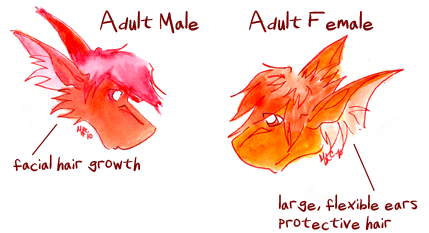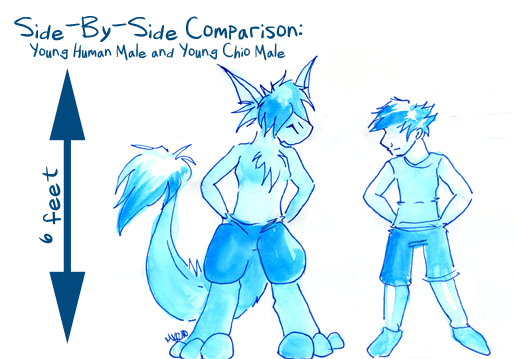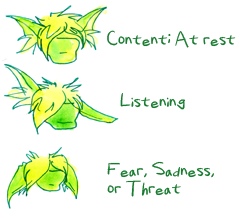A Brief Exploration of Physiology and Species History
The Chios are a race of genetically engineered human-animal hybrid creatures originating in the mid-21st century. The term can refer to both the species as well as the culture they live in, and is thus capitalized. It is pronounced “chee-oh,” or “chee-ohs” when plural.
Physiology:
The average adult Chio stands approximately six feet tall when upright, and weighs approximately 200 pounds. Females tend to be slightly shorter in stature than males. Their bodies are covered in a fine, velvety fur which ranges in color from light, sandy, blond to dark, earthy, brown. Their heads and tips of their tails are covered in longer, softer hair similar to human head hair. This hair is generally a different shade than the body fur, but can also be the same shade. Male Chios tend to have “beards” along the sides of their faces, while females do not.
Chios have strong, densely muscled tails which are quite flexible, but primarily used for balance when running. Their hind legs are digitigrade, which means they bear their weight on the large toes of their feet instead of planting their feet flat from heel to toe as humans do. They tend to use all fours when running or sprinting, and stand upright on two legs when walking or socializing. Their hind legs are quite strong, and allow them to chase prey with speed and pounce with swift agility. A well aimed kick with the feet or blow from a Chio tail can be devastating, and is one of their defense mechanisms when in danger. Chio hands have three fingers and one opposable thumb. The fourth finger exists as a structure within the hand to help absorb shock when running on all fours.
Chios are very well suited to dry desert climates, with many adaptations that make them excellent survivalists. Their long, distinctive ears are extremely sensitive and can hear a range of sounds that are inaudible to human ears. The ear itself is supported by thick cartilage covered in a thin layer of skin, and the inner ear is protected from environmental dust and dirt by a tuft of hair. The ears can twist and flex in several directions much as a cat’s ears do to better determine the source and distance of a particular sound. This motion is also used as a means of expression; ears at rest express contentment or comfort; upturned ears express listening or caution; backed or flattened ears express sadness, fear, or are part of a threat display, as this position affords protection in a sudden attack.
Chio vision is approximately on par with human vision, although the eyes are slightly larger than human eyes to fit their slightly larger skulls. Their sense of smell, on the other hand, is far superior to a human’s. Their large snouts house a well-developed olfactory system, which can detect faint odors from a much greater distance than a human can. The nostrils are located on the end of the snout near the tip on either side of the nasal ridge, but are protected by a delicate flap of skin to keep dust out. When tracking a scent, a Chio can open these flaps wide, but normally they remain nearly closed.
A typical desert Chio diet consists of smaller animals and the occasional plant. They are not picky about their food, and will eat most anything. As they are intelligent, social creatures, they tend to collect and store food when possible. They will also dig for a water source to provide hydration for their village.
The lifespan of an average, healthy Chio is approximately 40 years. Chios reach adulthood and sexual maturity around the age of thirteen years, at which point they choose mates and produce offspring. The reproductive process is similar to that of humans and other mammals, although the gestation period is shorter at eight months. Chios are born one at a time, or in rare cases as twins. When the baby is born, it nurses from its mother for about six months until it learns to hunt on its own. A newborn Chio learns to walk very early, about one month after it is born. Chio children remain with their parents until they reach adulthood.
As a reference, Chios age approximately twice as quickly as humans do. One “Chio year” is equivalent to two “human years.” Thus, they age quite rapidly.
History of the Species:
The Chios originated from an experiment conducted in the mid-21st century by Lenore Biotech, an American pharmaceutical and medical supply company. Their “ancestors,” the first organisms created by Lenore, were little more than living incubators for human transplant organs derived from human DNA. They were developed as part of a new procedure for organ transplants, which hoped to eliminate the need for organ donor lists. A new organ, such as a heart, liver, or kidney, could be grown from the patient’s own cells and inserted into one of these early organisms until it matured enough for use in the transplant.
As the project gained success, other major corporations began to supply funding, and new experiments were developed. These other experiments involved the creation of the first fully developed genetically engineered animal partially derived from human DNA; the Chio. The intended purpose for these experiments was broad and vague at best; divisions included research for military, medical, and general labor applications, but little is known specifically about the trials or results of the Chio experiments.
![[messenger]](https://www.messenger-comic.com/messenger/wp-content/uploads/2016/06/header.jpg)


